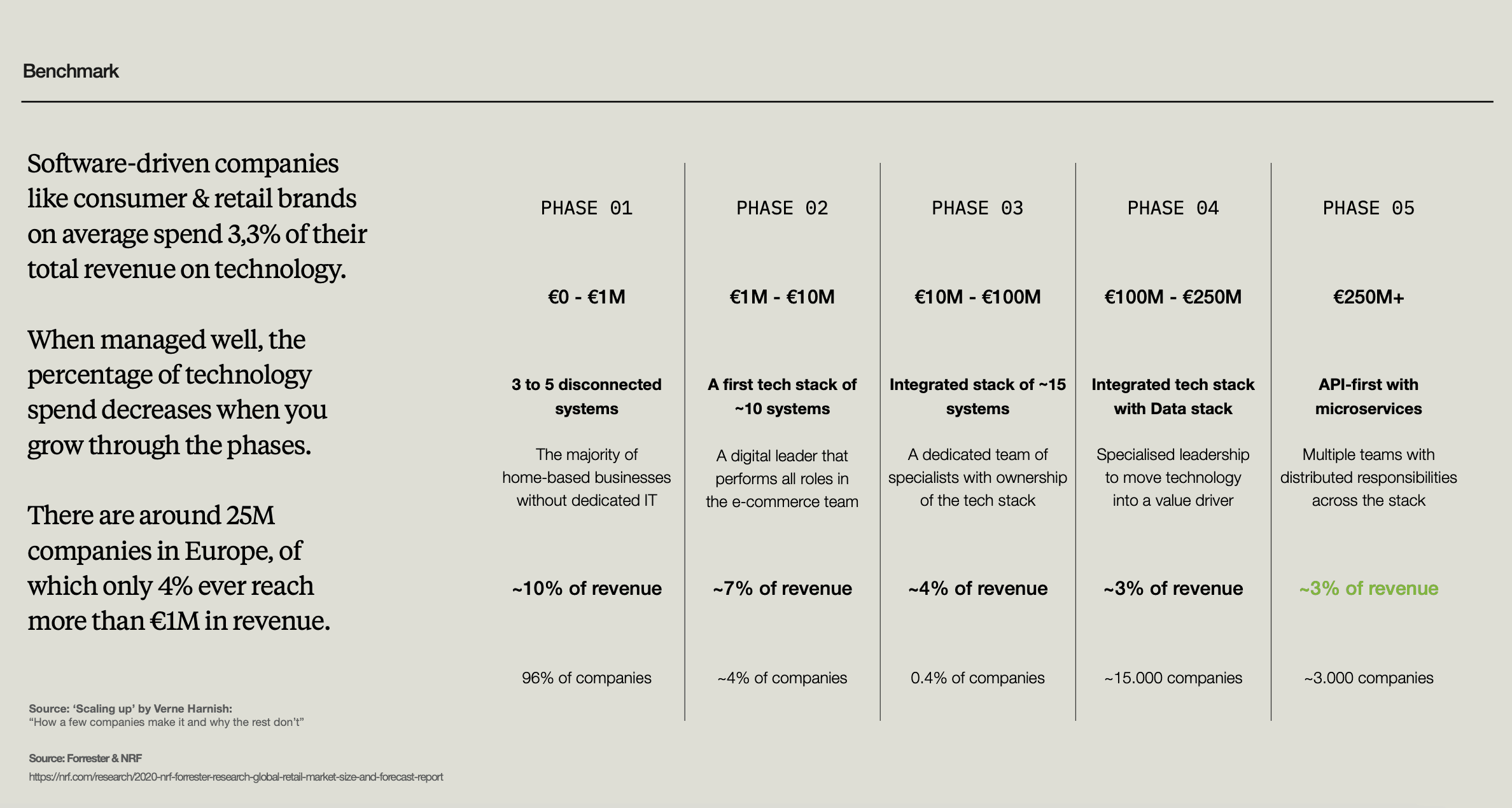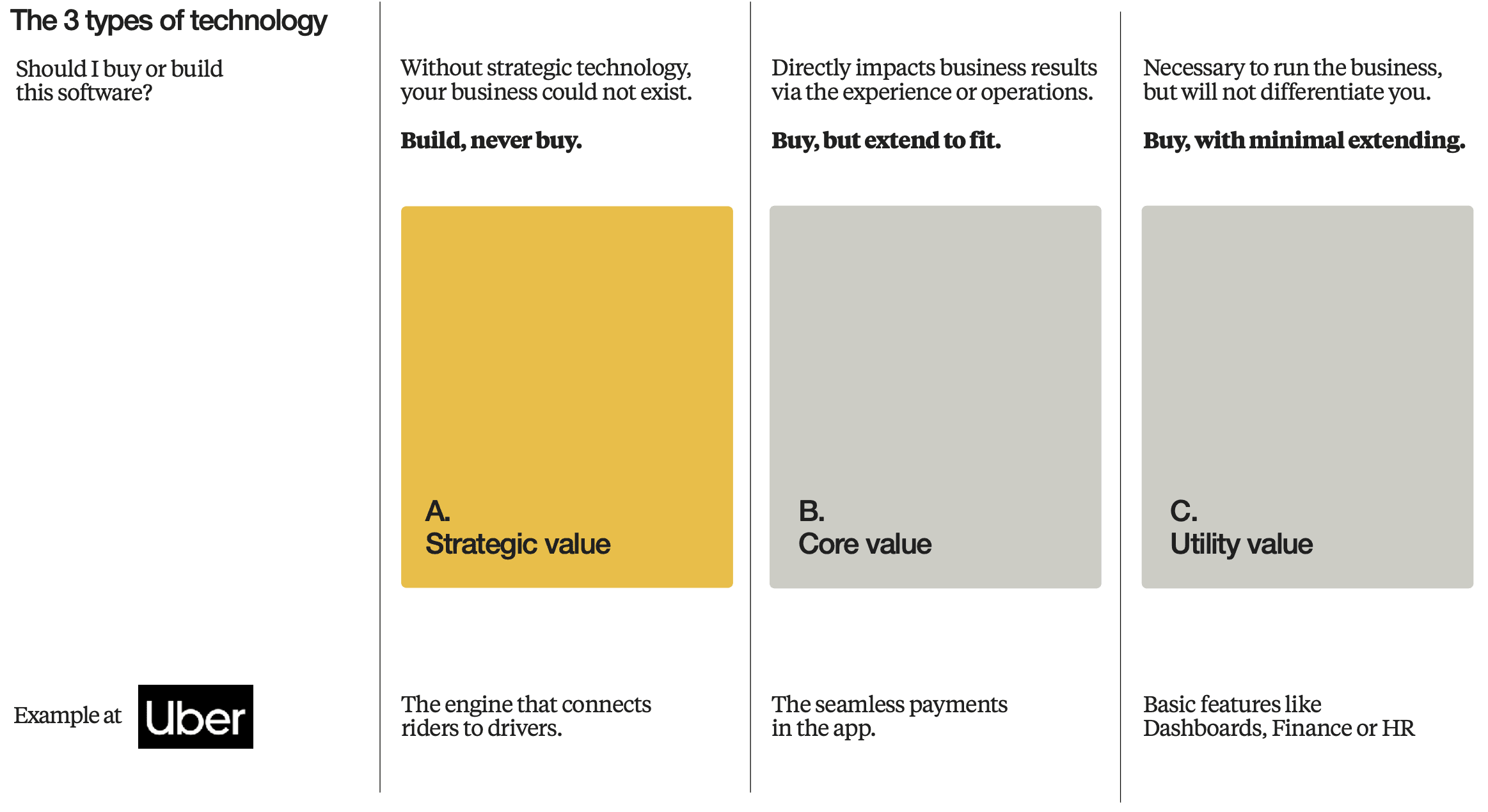


Nov 14, 2024
Nov 14, 2024
Making Technology Decisions in E-commerce: A Growth Stage Guide
Making Technology Decisions in E-commerce: A Growth Stage Guide

Aurelija Vycaite
Aurelija Vycaite
Jons Janssens
Jons Janssens
Strategy
The success of your e-commerce business increasingly depends on technology.
But here's the crucial insight many miss: technology should never be a goal in itself.
Instead, it serves as the infrastructure for your mission-critical operations and growth ambitions.
Let's break down how to make smart technology decisions as you scale.
Disclaimer: While these growth stages provide a useful framework, they're just a rule of thumb based on patterns we've observed. Every business is unique, and your optimal technology decisions will depend on various factors beyond revenue size alone. The key is understanding your specific business context before making any technology decisions.
The success of your e-commerce business increasingly depends on technology.
But here's the crucial insight many miss: technology should never be a goal in itself.
Instead, it serves as the infrastructure for your mission-critical operations and growth ambitions.
Let's break down how to make smart technology decisions as you scale.
Disclaimer: While these growth stages provide a useful framework, they're just a rule of thumb based on patterns we've observed. Every business is unique, and your optimal technology decisions will depend on various factors beyond revenue size alone. The key is understanding your specific business context before making any technology decisions.
01 Understanding Growth Phases
01 Understanding Growth Phases
Based on research and our experience helping consumer brands scale beyond €200M, companies typically move through distinct growth phases:


Based on research and our experience helping consumer brands scale beyond €200M, companies typically move through distinct growth phases:


Based on research and our experience helping consumer brands scale beyond €200M, companies typically move through distinct growth phases:


Based on research and our experience helping consumer brands scale beyond €200M, companies typically move through distinct growth phases:


02 Key principle: simplify before you scale
02 Key principle: simplify before you scale
Here's our golden rule at Conway & Co: first buy and extend, before you custom build.
Many companies make the mistake of seeking uniqueness in every aspect of their operation. Ask yourself: do you really need a unique fulfillment process? Usually, the answer is no. Your uniqueness should come from your brand, product, and content - not your backend operations.
Making Technology Decisions by Growth Phase
Let's look at specific recommendations for each phase. Remember, every business is unique, and your optimal technology decisions will depend on various factors beyond revenue size alone.
Phase 1: Early Stage
Start with proven, off-the-shelf solutions
Focus on commerce platform, basic analytics, and essential marketing tools
Bend your processes to fit standard systems
Avoid custom development
Prioritize speed to market over perfect functionality
Phase 2: Consolidation
Begin integrating systems for better data flow
Add specialized tools for growing needs (OMS, CDP)
Start measuring tech stack performance
Consider headless commerce if complexity requires
Focus on removing friction from processes
Phase 3: Growth
Implement proper data infrastructure
Consider custom development for strategic areas
Focus on scalability and automation
Build team capabilities around tech stack
Invest in business intelligence
Phase 4+: Scale
Move to API-first architecture where needed
Build custom solutions for strategic advantage
Focus on modularity and flexibility
Invest in advanced analytics and AI
Maintain balance between custom and off-the-shelf
Here's our golden rule at Conway & Co: first buy and extend, before you custom build.
Many companies make the mistake of seeking uniqueness in every aspect of their operation. Ask yourself: do you really need a unique fulfillment process? Usually, the answer is no. Your uniqueness should come from your brand, product, and content - not your backend operations.
Making Technology Decisions by Growth Phase
Let's look at specific recommendations for each phase. Remember, every business is unique, and your optimal technology decisions will depend on various factors beyond revenue size alone.
Phase 1: Early Stage
Start with proven, off-the-shelf solutions
Focus on commerce platform, basic analytics, and essential marketing tools
Bend your processes to fit standard systems
Avoid custom development
Prioritize speed to market over perfect functionality
Phase 2: Consolidation
Begin integrating systems for better data flow
Add specialized tools for growing needs (OMS, CDP)
Start measuring tech stack performance
Consider headless commerce if complexity requires
Focus on removing friction from processes
Phase 3: Growth
Implement proper data infrastructure
Consider custom development for strategic areas
Focus on scalability and automation
Build team capabilities around tech stack
Invest in business intelligence
Phase 4+: Scale
Move to API-first architecture where needed
Build custom solutions for strategic advantage
Focus on modularity and flexibility
Invest in advanced analytics and AI
Maintain balance between custom and off-the-shelf
03 The Three Types of Technology Value
03 The Three Types of Technology Value
When making technology decisions, categorize each system:
Strategic Value (Build, never buy)
Core to your competitive advantage
Directly impacts customer experience
Example: Uber's ride-matching algorithm
Core Value (Buy, but extend)
Important but not differentiating
Customize to fit your needs
Example: Payment processing systems
Utility Value (Buy, minimal extending)
Necessary but not strategic
Standardized functionality
Example: HR systems, email

When making technology decisions, categorize each system:
Strategic Value (Build, never buy)
Core to your competitive advantage
Directly impacts customer experience
Example: Uber's ride-matching algorithm
Core Value (Buy, but extend)
Important but not differentiating
Customize to fit your needs
Example: Payment processing systems
Utility Value (Buy, minimal extending)
Necessary but not strategic
Standardized functionality
Example: HR systems, email

Final Thoughts
Final Thoughts
Remember Conway's Law: your organization's structure will be reflected in your technology architecture. This means technology decisions aren't just technical choices - they're strategic business decisions that should be made in the boardroom, not the basement.
The goal isn't to have the most advanced tech stack, but rather the most appropriate one for your current stage and future ambitions. Focus on simplification where possible, and only add complexity where it truly serves your business strategy.
Remember Conway's Law: your organization's structure will be reflected in your technology architecture. This means technology decisions aren't just technical choices - they're strategic business decisions that should be made in the boardroom, not the basement.
The goal isn't to have the most advanced tech stack, but rather the most appropriate one for your current stage and future ambitions. Focus on simplification where possible, and only add complexity where it truly serves your business strategy.
Making Informed Decisions
Making Informed Decisions
While these growth stages provide helpful context, they're just a rule of thumb. Every business has unique needs shaped by multiple factors beyond revenue size.
For a detailed framework on making technology decisions, see our guide on "The 6 Essential Parameters for Choosing Your Technology Stack."
Ready to evaluate your technology stack? Consider a Conway Tech Stack Audit to get expert assessment of your current state and a clear roadmap aligned with your business ambitions.
While these growth stages provide helpful context, they're just a rule of thumb. Every business has unique needs shaped by multiple factors beyond revenue size.
For a detailed framework on making technology decisions, see our guide on "The 6 Essential Parameters for Choosing Your Technology Stack."
Ready to evaluate your technology stack? Consider a Conway Tech Stack Audit to get expert assessment of your current state and a clear roadmap aligned with your business ambitions.
Stay in the loop
Subscribe to our newsletter to learn how to build world-class digital experiences and get fit for digital growth.

Stay in the loop
Subscribe to our newsletter to learn how to build world-class digital experiences and get fit for digital growth.

Stay in the loop
Subscribe to our newsletter to learn how to build world-class digital experiences and get fit for digital growth.

Stay in the loop
Subscribe to our newsletter to learn how to build world-class digital experiences and get fit for digital growth.
